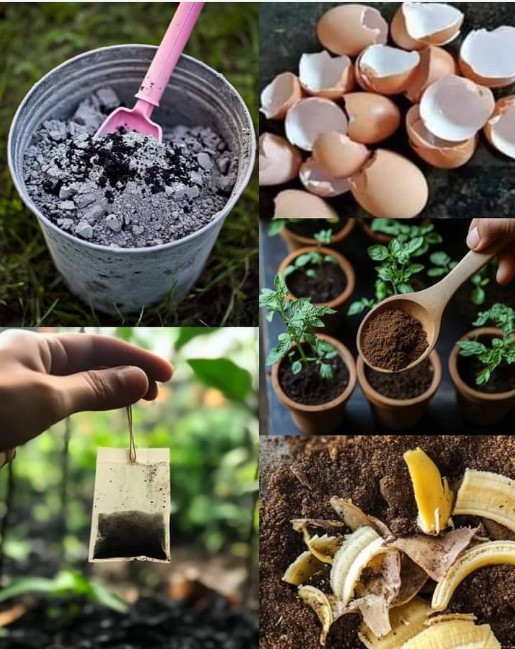12 Easy Homemade Fertilizers for Thriving Plants
Using everyday household items, you can create effective and eco-friendly fertilizers to nourish your plants. Here’s a list of simple, natural options that are both affordable and sustainable.
1. Banana Peels
- Nutrient: Rich in potassium and phosphorus.
- How to Use: Chop and bury banana peels near the roots of plants, or soak them in water for 24-48 hours to create a potassium-rich fertilizer tea.
- Best For: Flowering plants, tomatoes, and peppers.
2. Coffee Grounds
- Nutrient: Provides nitrogen and improves soil texture.
- How to Use: Sprinkle used coffee grounds around the base of acid-loving plants like roses, azaleas, and blueberries.
- Tip: Avoid overuse, as it can make the soil too acidic.
3. Eggshells
- Nutrient: Packed with calcium to strengthen plant cell walls.
- How to Use: Crush and sprinkle eggshells around the base of plants or blend them into powder to mix with soil.
- Best For: Tomatoes, peppers, and houseplants.
4. Epsom Salt
- Nutrient: Provides magnesium and sulfate, essential for photosynthesis.
- How to Use: Dissolve 1 tablespoon in 1 gallon of water and spray on plants every 2-4 weeks.
- Best For: Vegetables, roses, and houseplants.
5. Molasses
- Nutrient: Supplies carbohydrates to feed beneficial microbes in the soil.
- How to Use: Dilute 1 tablespoon of unsulfured molasses in 1 gallon of water and use as a soil drench.
- Best For: All plants needing a microbial boost.
6. Aquarium Water
- Nutrient: Contains nitrogen, phosphorus, and beneficial microorganisms.
- How to Use: Use water from freshwater aquariums to water your plants directly.
- Best For: Houseplants and garden vegetables.
7. Wood Ash
- Nutrient: Adds potassium and calcium carbonate to the soil.
- How to Use: Sprinkle wood ash sparingly around plants or mix it into compost. Avoid using it on acid-loving plants.
- Best For: Lawns, vegetable gardens, and fruit trees.
8. Gelatin
- Nutrient: A source of nitrogen for leafy plant growth.
- How to Use: Dissolve 1 packet of unflavored gelatin in 1 cup of hot water, then dilute with 3 cups of cool water and pour around plants.
- Best For: Leafy greens and houseplants.
9. Milk
- Nutrient: Provides calcium and proteins to promote plant health.
- How to Use: Mix 1 part milk with 2 parts water and spray on leaves or pour into the soil. Avoid overuse to prevent sour smells.
- Best For: Tomatoes, peppers, and roses.
10. Seaweed
- Nutrient: Contains essential minerals and growth hormones.
- How to Use: Rinse fresh seaweed to remove salt, chop it, and steep in water for a few days. Strain and use as a liquid fertilizer.
- Best For: All-purpose use, especially for vegetables and flowers.
11. Vegetable Scraps
- Nutrient: Rich in a mix of nutrients from various vegetables.
- How to Use: Boil vegetable scraps in water, strain, and cool the liquid before pouring it onto plants.
- Best For: Indoor and outdoor plants needing an all-purpose boost.
12. Weed Tea
- Nutrient: Extracts nitrogen and minerals from weeds.
- How to Use: Steep weeds (like dandelions or clover) in a bucket of water for 1-2 weeks, then dilute the tea (1 part tea to 10 parts water) before applying.
- Best For: Lawns, garden beds, and perennials.
These homemade fertilizers not only reduce waste but also ensure your plants receive natural nourishment. Experiment with these easy-to-make solutions and enjoy the benefits of a thriving, greener garden! 🌱
